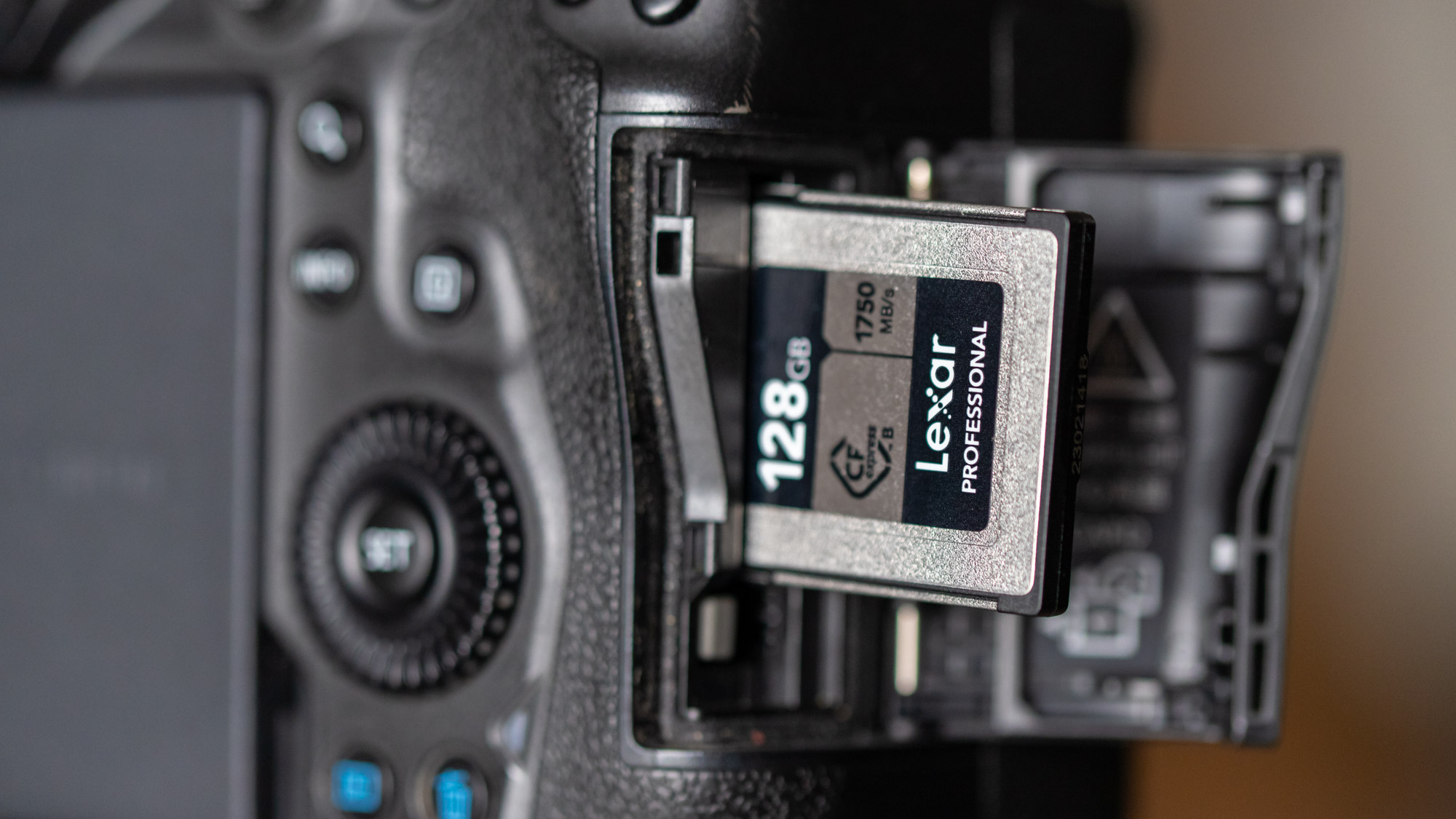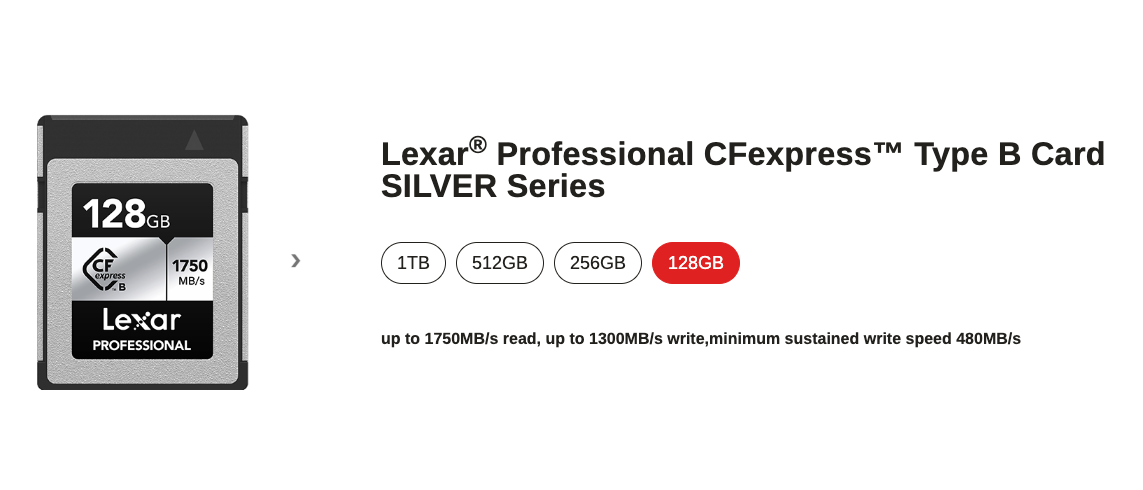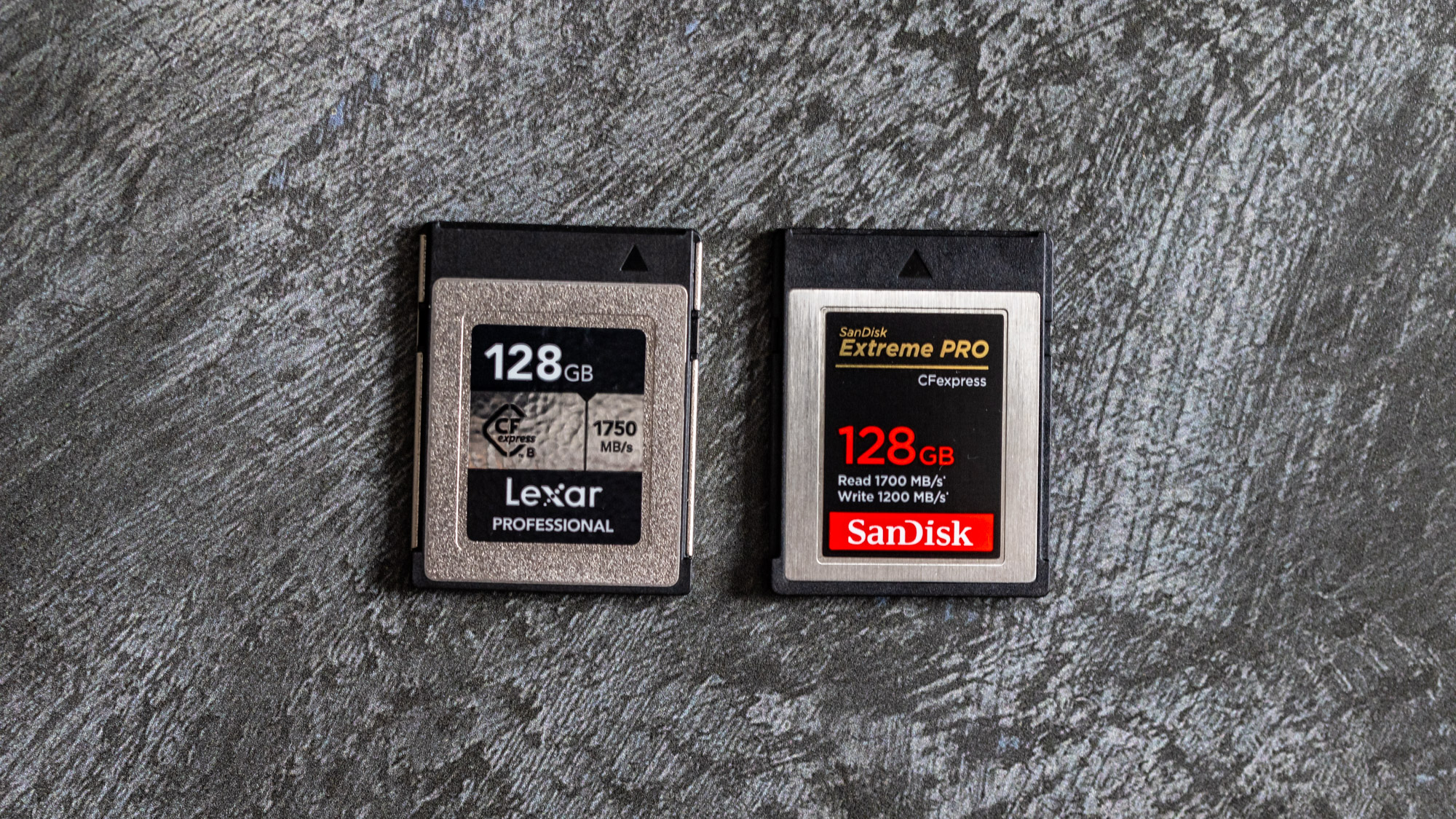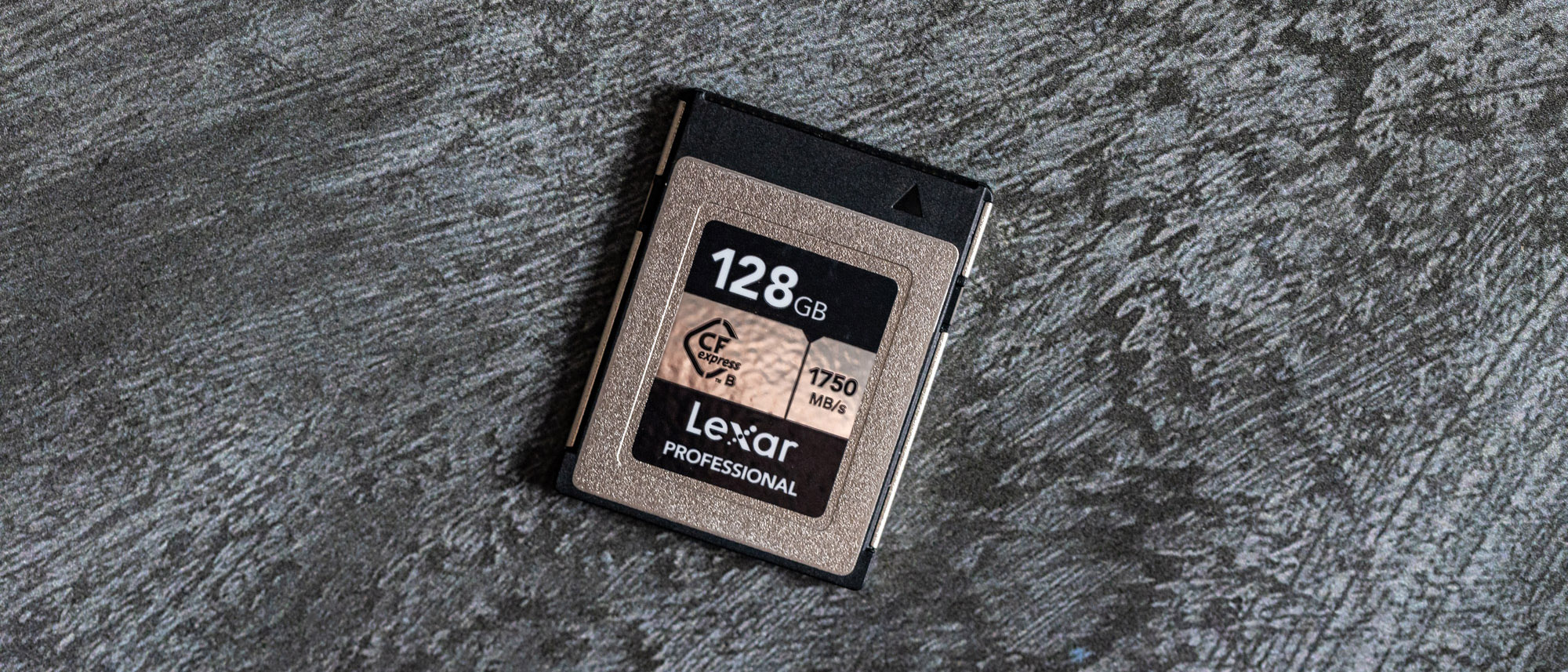Digital Camera World Verdict
It’s crazy to think that 128GB isn’t that much memory, especially when my first camera memory card was 128MB in the early 2000s! But in the modern world we live in with super high-resolution camera sensors and demands for 4K or even 8K video a 128GB card can get filled up pretty quickly. The good news, however, is that Lexar’s memory is so attractively priced that you’ll be able to buy multiple cards for a fraction of the cost of a single card from its main competitor.
Pros
- +
Attractive price-point
- +
Four capacity options
- +
XQD Compatible
- +
Can be used for 8K video
- +
More robust than an SDXC card
Cons
- -
Write and read speed changes depending on capacity
- -
128GB isn’t a huge amount of data in the modern age
- -
More expensive and bigger than SDXC cards
- -
Doesn't come with any recovery software
Why you can trust Digital Camera World
Compact Flash, or CF cards for short, have been on quite the journey over the years, with the original CF card format coming out in 1994 and quickly becoming popular with camera manufacturers as they transitioned from film to digital. CFast cards then came out in 2008 and once the limitations of the CF form factor were outgrown in the 2010’s we transitioned to faster XQD cards in 2011. These were superseded in 2017 by the modern CFexpress cards we see today and take the same form factor as the older XQD cards.
It’s worth noting that CFexpress cards come in Type A versions, with read and write speeds of around 800MB/s or 700MB/s respectively, whereas on Type B cards it's much faster at up to 1800MB/s (read) or 950MB/s (write). They're also physically different sizes and incompatible with each other's system, so it's crucial you pick the correct one for your camera if it has a CFexpress slot.
SanDisk was an early adopter of the CFexpress Type B card variety so it's no surprise that its ExtremePRO range has been a popular choice for many working professionals. But there's a new kid on the block and in this review we take a closer look at Lexar’s Professional SILVER series which is over half the price, yet boasts both faster read and write speeds. Let’s put it through its paces to find out if it really is all it’s cracked up to be, or if it’s too good to be true...
Specifications
Supported cards: CFexpress Type B (with XQD compatibility)
Interface: PCIe Gen3x2
Max write speed: 1300MB/s
Max read speed: 1750MB/s
Capacities: 128GB, 256GB, 512GB, 1TB
Operating temperature: -10ºC - 70ºC
Warranty: 10 year limited warranty
Size (LxWxH): 29.60 x 38.50 x 3.80 mm / 1.16” x 1.51” x 0.14”
Weight: 7.65g / 0.016 lbs
Key Features
Flagship cameras such as the Canon EOS R1 will be the choice of many pros at this year's Paris Olympics and there's a good reason that flagship cameras only use CFexpress Type B cards - they’re superior in speed and durability compared to your humble SD card.
CFexpress cards have a larger, chunkier design compared to traditional SD cards which makes it possible to squeeze in faster and higher capacity silicone, but it also means they feel more sturdy and robust when compared to SD cards.
One of the drawbacks of SD cards is that I’ve had multiple breaks over the years, so the larger, sturdier design of CFexpress cards inherently makes them stronger and more reliable. That’s no different with Lexar’s SILVER range either, the CFexpress Type B card we got hold of has more metal around the back and sides compared to the SanDisk ExtremePRO. This extra metal might even help with heat dissipation too, acting a bit like a heatsink. We’ll come on to the performance and explore its read and write times later on in the review.

The 128GB Silver card is also manufactured in Taiwan, whereas the SanDisk Extreme PRO cards are produced in China. In the box is a plastic hard case to keep it safe and secure in your kit bag too when not in use or you’ve filled it up and need to switch cards.

Lexar states that all of its products “undergo extensive testing in the Lexar Quality Labs, facilities with thousands of different cameras and digital devices to ensure performance, quality, compatibility, and reliability”. They also come with a 10-year limited warranty, it doesn't match SanDisk's whopping 30-year guarantee, but it's impressive nonetheless.
While we have been critical of SanDisk’s high price point in this review when compared to our Lexar review sample, one noteworthy difference is that SanDisk Extreme PRO cards come with 1-year of the company’s handy RescuePro Deluxe software which can help users recover images even if the data was deleted or the drive was formatted. There’s no such recovery software included with the Lexar SILVER series, but at such a considerable price difference it’s a sacrifice some users will be happy to make.
Performance
Lexar claims its SILVER series delivers next-generation performance and seamless 8K video capture.
While all four of the capacities in the SILVER series have read speeds of up to 1750MB/s and write speeds as high as 1300MB/s, the minimum sustained write speeds seem to vary wildly between them. For the base 128GB and 256GB versions, it’s just 480MB, for the 512GB card it’s 850MB/s and for the top 1TB model, it’s a blisteringly fast 1200MB/s - almost three times as quick as the base 128GB iteration.

For comparison Lexar’s professional GOLD series have read and write speeds of 1750/MBs and 1500MB/s for its base 128GB model, reaching up to 1900MB/s and 1500MB/s read and write times respectively for its largest 2TB and 1TB models.
Perhaps the more noteworthy stats are that the GOLD series boasts a sustained write speed of a gigantic 1000MB/s for its 128-512GB capacity cards, or 1300MB/s for its 1TB and 2TB cards. The GOLD series also boasts better IP5X dust protection, claims to be temperature-proof, has 5m drop resistance, and withstands 70N compression resistance.
Lexar's SILVER series has a very impressive build quality, but the GOLD series takes it to another level and also provides better minimum sustained write speeds and higher capacities, so is definitely one to consider if you need those extra features.

For testing, we had the 128GB versions from Lexar's SILVER and SanDisk's ExtremePRO ranges.
To test our CFexpress Type B cards we transferred our data to and from a Samsung T7 Portable SSD via USB-C - this should in theory allow the CFExpress cards to operate as fast as they possibly can.
First up we did a test of write speeds. The Lexar Silver claims to have a read speed of 1750MB/s against SanDisk’s 1700MB/s so there’s only a 3% difference between the two here. Unsurprisingly both managed to copy over a folder of 25GB RAW files from cards to our SSD drive both in a blistering 38 secs, so both impressed us here with identical times.
When it came to write speeds there was however a much more notable difference. While Lexar claims a write speed of 1300MB/s and SanDisk claims 1200 MB/s, the Lexar card should be 8.3% faster, but these figures give a 'best case scenario', the minimum sustained write speed of 480MB/s for the Lexar is likely to be a much more accurate measure.
Copying a 50GB folder from our SSD to the cards we saw a big difference between the two. The SanDisk Extreme PRO 128GB took 123 seconds to write 50GB and had an average write speed of around 450MB. The Lexar Silver 128GB however was finished in just 101 seconds and had an average write speed of 510MB, so our testing found it to be approximately 17% faster!
Verdict
Lexar’s Professional CFexpress Type B card SILVER series is a no-brainer. While it might look conspicuous with every other Type B CFexpress card on the market, Lexar’s SILVER card is clearly built differently on the inside.
In our tests, the Lexar Silver 128GB had read speeds that matched that of the SanDisk ExtremePRO, though it was considerably quicker when it came to write speeds: a feat made even more impressive when you consider it's half the price! It also regularly appears in our Amazon Day and Black Friday Deals which makes it even better value. It might be silver by name, but it's a gold standard card in our eyes.
The only reason we'd consider not buying the Lexar SILVER is if you need those enhanced features from its GOLD series, or you like the idea of having SanDisk's Rescue Pro Deluxe software - though buying a SanDisk card only grants you one year of the software for free.
| Features | There’s a lot to like about the Lexar Silver 128GB. It supports XQD compatibility, uses the PCIe Gen3x2 interface, has solid maximum read and write speeds as well as a 10 year warranty. | ★★★★★ |
| Performance | With our setup it matched the SanDisk ExtremePRO 128GB model for read speed, but it was the sustained write speeds which impressed. Here the Lexar Silver put in a solid shift and we found it to be about 17% faster than its competition. | ★★★★★ |
| Value | The Lexar Silver is over half the price of the SanDisk ExtremePRO which has dominated the market for so long. The Lexar cards also often appear in Amazon Prime Day and Black Friday deals which makes them even more of a steal! | ★★★★★ |
Should you buy the Lexar Professional Silver 128GB CF Express Type B card?
✅ Buy this if...
- You have a camera that takes CFexpress Type B memory cards
- You're on a budget or looking for a great value memory card
- You're looking for a well built and reliable memory card which outperforms its competition
🚫 Don't buy this if...
- You need the higher capacity, enhanced speeds and weather resistance from Lexar's GOLD series
- You want peace of mind from recovery program such as SanDisk’s Rescue Pro Deluxe Software which comes included with SanDisk's CFexpress cards
Alternatives

Deputy Editor on PhotoPlus: The Canon Magazine, Dan also brings his technical wizardry and editing skills to Digital Camera World. He has been writing about all aspects of photography for over 10 years, having previously served as technical writer and technical editor for Practical Photography magazine, as well as Photoshop editor on Digital Photo.
Dan is an Adobe-certified Photoshop guru, making him officially a beast at post-processing – so he’s the perfect person to share tips and tricks both in-camera and in post. Able to shoot all genres, Dan provides news, techniques and tutorials on everything from portraits and landscapes to macro and wildlife, helping photographers get the most out of their cameras, lenses, filters, lighting, tripods, and, of course, editing software.



